|
Here it is - This is an authentic early 60s era Crackerbox boat
skinned in marine grade plywood and powered by a 1959 Corvette small
block Chevy 283. Who wouldn't love the the nostalgic lines of the Crackerbox?.
And with a previous Glen-L project under my belt (the
TNT), I was gearing up for a build. After purchasing plans for the Crackerbox
from Glen-L when
I found this one for sale near by in Livermore CA.
Since boat building is never a positive cash value
prospect - it's always better to buy a boat than to build one. Other than the
personal satisfaction, there's no reason to build if you can find what you
want for sale.
This boat was built for racing - Period! So far as
I've been able to learn - In its 60s heyday, the Crackerbox was usually built
by amateur racers. It would feature a late 50s small block Chevy 283 V8. Small
block Chevy 283 power plants were often harvested from smashed up Corvettes
of the same era in local junkyards throughout the country. Note that this engine
is not exclusive to the Chevy Corvette. It was also featured in Chevy trucks,
including full sized work trucks and the El Camino.
The small block Chevy 283 of this era is an extremely ballsy engine
given its smaller displacement. The chief engineer in the Chevy engine department
at this time (anyone got his name?)
Credits to Dusty - NCRS # 23655 for answerng the above question with the following quote:
The Chief Engineer in the Chevy engine department at that time was Zora Arcus Duntov known for putting performance into Chevrolet V-8 starting in 1956 and his Special Duntov Camshaft made Chevrolet Corvette a racing legend Zora was a living legend up to a few years ago when he died, but his legacy lives still lives on.
|
was
known for using slightly "over" cams. Meaning that there would be
a greater overlap in the time that the intake and the exhaust valves were open
at the same time - understand, that with few exceptions, horse power and fuel
economy are not very compatible, and that volumetric efficiency is the key
to building horse power.
BTW, If you enjoy woodworking take a look...
This Crackerbox is a purely authentic example. I know
little of its history, but its pedigree is easily verifiable. The power plant
is verified late 50s small block Chevy 283. And man, canit pull !!! Many of
the other components such as valve covers, timing chain cover, etc. are of
the same era. - Cal Custom went out of business years ago. But their
parts have held up perfectly for all these years.
I know it is not a Glen-L, since I have purchased the
plans and patterns for that boat. Comparing those plans and patterns to my
Crackerbox it becomes quite obvious. Having gone through every square inch,
inside and out, I know it's not a Glen-L. The Glen-L has a different arrangement
of bulkheads - and one less bulkhead. From the outside, the only really obvious
differences are two:
- The Glen-L has a more rounded transom than does this Crackerbox. Rounded
at the shear line that is. I find the Glen-L rounded transom much more fitting
the nostalgic look of the boat. Very attractive. Oh well.
- The beam, or height of the Glen-L is a little higher. But this gives me
a feeling of a more boxy or square look. Not a harsh criticism or anything,
but more of a preference that I do not share.
These are the most recent pics as of 2005. Click on
a thumbnail for a larger view.
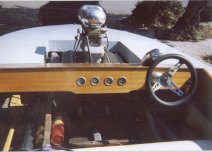
Though the light is not good here, if it were, you
would be able to see what is usually the front of the engine in an automotive
installation. The correct rotational direction of the engine dictates that
power is taken off of the 'front' of the engine. You can see this in other
pictures, the position of the distributor.
Also, invisible in this picture (see other photos
below) are the drive line workings. Very simple. Power is transferred from
the engine through a flexible coupling the the drive shaft. That's it! No
transmission, no neutral, no reverse.
This boat has only two speeds. Fast and stop.
|
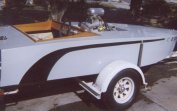
Here we see another picture, clipped off and everything.
I promise to redo these pictures next weekend.
|
|
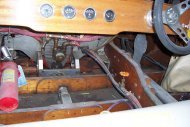
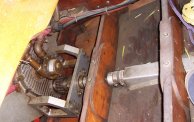
Annotated
|
Here's a better picture of the drive system. Ignore
the garage dust that has collected. What we can see here, is the 'front
of the engine' (in a car) . In this application, the power is taken off
the radiator side of the engine. Below the water pump is the chain-link
flexible coupling, connecting the small block Chevy 283 crack shaft to the
prop shaft.
A flexible coupling is never a substitution for
proper engine alignment. But a hard coupling between two rotating shafts,
no matter how perfectly aligned, would be a destructive idea, to say the
least.
The aluminum cage bolted to the engine block mounts
a radial pillow block which accommodates the rotation of the prop shaft
(backside of the cage plate). A thrust bearing and and shaft collars are
on this side of the plate to transfer thrust to the engine block - not the
crack shaft! (Achem, original builder!)
Finally there's the stuffing box as the prop shaft
exits the hull.
|
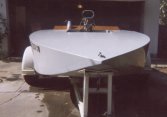 |
You should hear this thing go. That little small
block Chevy 283 purrs like an angry kitten. The exhaust runs through the
transom below the waterline at idle. The bubbling sound of the exhaust is
like music. A quick blip of the the throttle will make any real mans heart
go pitty-pat with joy, but the whiplash aint so fun (remember, it's a direct
drive).
|
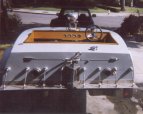 |
Humm, that looks cool. Adjustable trim plates, outboard rudder
cable system, and thru transom exhaust - classic small runnabout construction.
We can also see the flip-top nostalgic Corvette gas tank top - marine grade
of course, sold brass, beautifully chromed. |
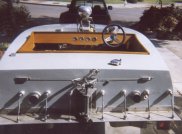 |
Slightly closer view. You can see the rotar for the rudder
here. After the waterline restoration, the steering cable was loose, which
hurt the handling profile. Crummy old hardware-store cable clamps were all
that held the cable tension static. No cable tensioning provision existed.
With a background in mechanical design, I had a local shop break and weld
some brackets that would allow me to tension the cable to between 60 and
80 lbs. Look at the back (nearest to you) of the rotar to see the threaded
tensioning mechanism. |
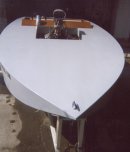 |
I added the tunnel ram a few years ago, mainly for
looks. It does help achieve higher RPMs but it seems that with such a large
plenum, it's probably a little over carburated at 600cfm and only 286 ci.
Here's some close ups of the tunnel ram.
To nail the throttle from idle causes a lean bog-down
until RPM comes up (due to the plenum size). The 600 CFM combined with the
original intake (I still have it) made a hole-shot rocket like you wouldn't
believe. But since I'm after a more hotrod nostalgic feel, I'm more concerned
about looks than hole-shot, so the tunnel ram stays. But I could install
the original hole-shot intake manifold in an afternoon.
Recarburating the tunnel ram intake with a smaller
CFM carb could give the best of both worlds.
|
Here's some thumbnails of the boat under way. As usual, click on a thumbnail
for a larger view.
|
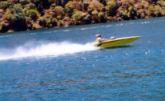 |
 |
 |
|
When
I bought the boat, it looked like this. Rather ugly, eh?
|
 |
Wow, what a paint job! I re-painted it as soon
as possible. Would you believe, the carb raiser under the air scoop is
a coffee can? !!! - In the immortal words of Rickey Ricardo - "eye
yeye yeye yeye yeye".
|
|
 |
 |
|
Good thing
I didn't let the horrible looks overshadow the beautiful boat underneath this
hideous paint job.
No
signs of a hull with any problem. Good as new
Note the
changes from the original. Besides the change in paint job.
- The small air scoop sitting
atop half a coffee can was removed in favor of a nice nostalgic bell shaped
air scoop.
- Lousy tachometer attached near
the steering wheel is replaced with a nostalgic deck mount tach tube.
- The proper boat type gas filler cap replaced with likewise marine flip
top cap similar in design to those found on Corvettes of the same vintage.
- The tunnel ram was installed after these changes.
Amongst many of the changes, these few are the most noticeable used to achieve
the desired nostalgic look that this design deserves. Despite the fact that
the Crackerbox has origins as far back as the 1920s (I suspect its original
purpose was mainly for boot legging whiskey) I felt that a more 50s nostalgic
look and feel would really be the best scheme for bringing out the beautiful
and unusual qualities of a Crackerbox.
Note: although the paint job has come a long way from when I bought it (pictures
above), the yellow base below prompted a few 'banana' comments. So the below
pictures are prior to the silver-gray used currently.
Scotts Crackerbox Racing Boat Specifications:
Hull
Length: 15 feet 6 inches
Beam: 6 feet
Draft: 2 feet 6 inches
Weight: heavy
Original Build Data: Early 1960's
Speeds: Two - fast and stop.
Engine
Year: 1959 small block Chevy 283 - Corvette bored 40 over
Carburetor: Holley 1502, stock carbueration
RPM: 5000
Sound: Purrs like an angry kitten outa hell!
Overall
Drive: Direct drive. No neutral or reverse
Prop: 12 inch diameter, 15 inch pitch
Speed: How fast you wanna go???
Steering: Outboard rudder with cable/pulley mechanism
|